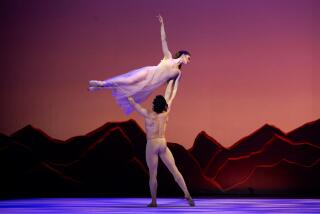The Many Faces of Odile-Odette
- Share via
It seems very much as if playing the dual role of good swan and bad swan in “Swan Lake” is more difficult than ever for today’s American Ballet Theatre dancers. At least, this is the conclusion following swan sightings at four different performances last week at the Orange County Performing Arts Center.
The good news is that Kevin McKenzie’s version of this classic grows on you--despite a few trouble spots; his streamlining often works; the added scenes that expand upon the creepiness of the sorcerer Von Rothbart make evil a more tangible presence than in mustier productions.
Yet the whole ballet never really fires unless the two main characters light the spark in the crucial white and black swan scenes.
With the depth of talent at ABT, few audience members go home thinking they’ve seen a badly danced swan or prince. And there’s always the invigorating first act pas de trois, which features a series of consistently vibrant soloists dancing with buoyant, affable charm. But finding a full-service Odette-Odile combination was rare.
Technical fireworks kept each black swan pas de deux lively at least; everyone had turns, leaps and legs out to there, and every Odile varied the theme of a wily seductress.
On Thursday, Paloma Herrera sent her serenely arched feet into high angles, and alternated single, double and triple turns in her fouette series as if the devil himself had wound her up.
She flashed smoldering, duplicitous glances that only a besotted, formerly shy prince (the supremely convincing Marcelo Gomes) wouldn’t suspect.
Saturday night, Irina Dvorovenko was a pretty, preening villainess, perhaps more aware of seducing the audience than her prince (the seriously elegant Maxim Belotserkovsky) but impressively swift and well-placed all the same.
The problem seemed to be with embodying the bewitched white swan, Odette. Her trembling, mourning vulnerability eluded both Herrera and Dvorovenko, as beautiful as were their stretched, angled postures. Nor could a resolutely sturdy Ashley Tuttle, partnered by Gennadi Saveliev on Wednesday night, breathe life into the character who needs, at the least, a few shivers running through a flexible spine and a more creature-like sensibility.
It looked as if these three couldn’t shuck their own authoritative gestures, couldn’t find a window into an eccentric, other self. Other swans at the lake also suffered from this disability.
With Gillian Murphy on Saturday afternoon, the specter of Odette’s suffering rose with utter believability and electricity. Pauses and pliability became fear and filigreed yearning; pirouettes that started delicately and built in strength were like the quickening of hope and resolve.
The drama was in the details, shared by her Prince Siegfried, Jose Manuel Carreno, who was also using an impeccable technique to tell a story. As he folded her into the several swan-wing embraces, their intensity matched that of Tchaikovsky’s exquisite violins.
In the black swan pas de deux, Carreno’s love was still blossoming, even as he was deceived by Murphy’s slyly manipulative Odile, and his sailing leaps and soft landings became all about his newfound happiness. Again, the score’s expansive, soaring clues were maximized by finely tuned emotions and timing.
Murphy’s long lines spread and folded for a reason, her go-for-it velocity in the turns impressed (and nearly derailed her, heightening the danger). The slow caress of her conquest’s face before flinging an arm back in victory punctuated the triumph masterfully.
When tragedy followed, it felt visceral, not old-fashioned, and the enthusiastic audience reaction raised the roof.
There were high points in other casts, but Murphy and Carreno were the gold standard. Love, innocence, evil, death, redemption--it was all there, in beautifully nuanced black and white.
More to Read
The biggest entertainment stories
Get our big stories about Hollywood, film, television, music, arts, culture and more right in your inbox as soon as they publish.
You may occasionally receive promotional content from the Los Angeles Times.










